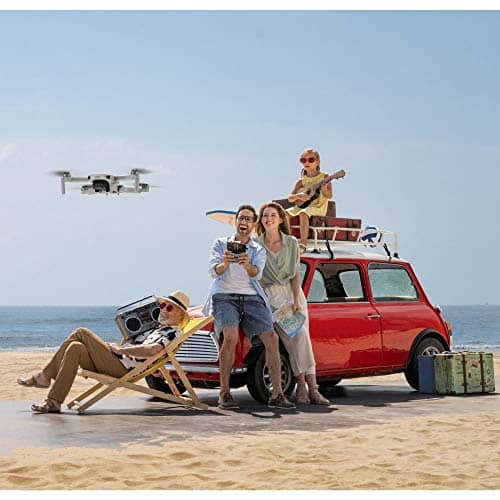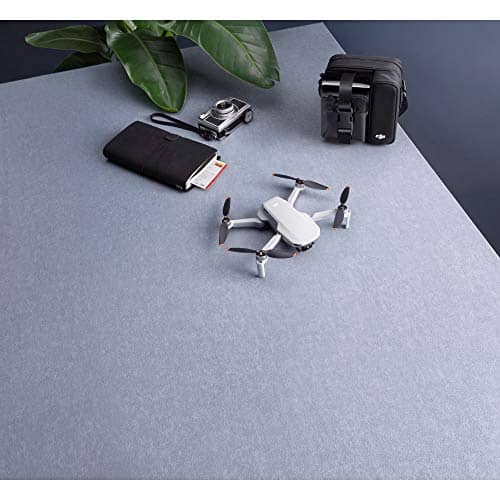DJI Mini 2 – 4K videos, RAW photos & more than 6 miles range
The DJI Mini 2 is here! Compared to its predecessor, the DJI Mavic Mini, the ultra-compact mini drone comes up with all kinds of new features: 4K videos at up to 30 fps, up to 6.2 miles (10 km) range thanks to OcuSync 2.0 and photos in RAW are just some of the new functions. Find out what else has changed and whether it is worth upgrading to the Mini 2 in our detailed report!
Design and weight
The DJI Mini 2 is available either as a standalone version or as a fly-more combo, with a high-quality carrying case (the same as the Air 2), two additional batteries and a practical mounting bracket to protect the drone during transport.
From a purely visual standpoint, the new DJI Mini 2 hardly differs from the DJI Mavic Mini. Except for small orange stripes on the propellers and a front LED that can be freely adjusted in color, both drones are completely identical on the outside.
What is new, however, is the name. DJI has banned the “Mavic” from the product name for the new version.
In terms of weight and size, however, almost nothing has changed. The DJI Mini 2 is just as compact and lightweight as its predecessor. When folded, the Mini 2 measures just 13.8 × 8.1 × 5.8 cm, making it no larger than most smartphones.
When unfolded, the small drone measures just 15.9 × 20.3 × 5.6 cm. According to DJI, the weight is about 242 grams, which is again slightly less than the first version of the Mavic Mini.
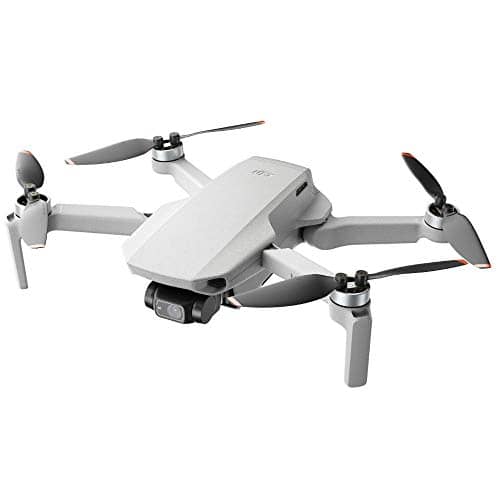
Equipment & flight characteristics of the DJI Mini 2

Equipped with a GPS module that has access to GPS, GLONASS and Galileo satellites, the DJI Mini 2 always has enough satellites available for positioning.
For even better stability, the built-in ground sensors are used in addition to the GPS at flight altitudes between 1.6 and 100 feet (0.5 and 30 meters). Especially when flying indoors, these help the drone to hold its position safely even without GPS reception.
However, since the Mini 2 still doesn’t have any obstacle sensors, you’ll have to be alert at all times when flying in confined spaces.
As expected, the DJI Mini 2’s Return-to-Home mode works with high precision and lets the drone return to the landing site safely. Even in the event of any loss of signal or low battery. However, if desired, the drone can also be set to descend or even hover if the signal is lost on the spot.
Faster & more wind resistant
Since DJI has given the Mini 2 new brushless motors, the drone can now reach speeds of up to 36 mph (57.6 km/h or 16 m/s) in Sport mode. The Mavic Mini stopped at 29 mph (46.8 km/h or 13 m/s).
The additional power of the motors also has a positive effect on wind resistance. It can now withstand even higher wind speeds (up to 25.3 mph or 5 Beaufort) than the Mavic Mini 1 (up to 18.4 mph or 4 Beaufort).
Despite this increased motor power, the drone has even become slightly quieter overall.
Flight time and range of the DJI Mini 2
According to DJI, the flight time of the DJI Mini 2 is up to 31 minutes, which is one minute more than the previous version. Depending on how fast you fly and whether you use the camera function for the entire flight or only partially, flight times of about 23 to 25 minutes are realistic, which are still very good values for such a small drone.
The long flight times are made possible by the DJI Mini 2’s new 7.7 V, 2250 mAh LiPo battery. Owners of the previous version can also be happy that their batteries also fit in the new version – although the other way around is not possible.
The battery is charged in about 90 minutes using the included USB-C charging cable. Please note that a charging station is only included in the Fly More Combo. If you buy the Mini 2 as a standalone version, simply use a standard power adapter, such as the one on your smartphone.
Another truly remarkable improvement is its outstanding range of up to 6.2 miles (10 kilometers) (FCC) or 5 miles (8 kilometers) (CE) in European airspace. The maximum ascent altitude is about 2.5 miles (4 kilometers) in each case.
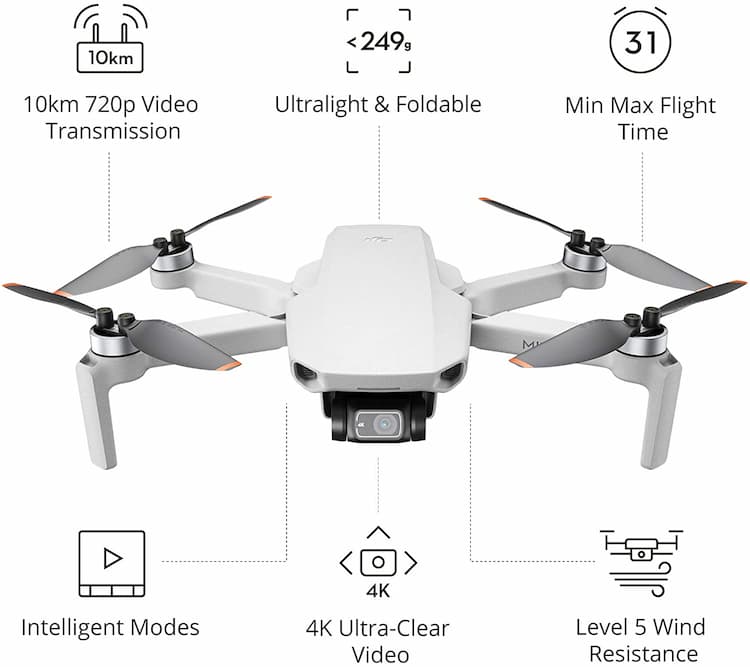
While the signal transmission of the DJI Mavic Mini still worked exclusively via Wi-Fi, the DJI Mini 2 now uses the OcuSync 2.0 professional transmission system, which is already known from other DJI drones such as the DJI Mavic 2 and stands for interference-free signal transmission over long distances.
The OcuSync 2.0 system offers considerable advantages in terms of signal stability. Interrupting the connection at distances of less than one mile is now virtually impossible, even if obstacles affect the radio transmission.
The remote control
DJI has not only updated the drone itself, but also the remote control. The light gray controller is larger (to accommodate the OcuSync 2.0 system) and more ergonomic. Basically, the new remote control is the same as the DJI Mavic Air 2.
We really like the new smartphone holder, which can now be extended upwards and offers enough space even for large smartphones. The antenna for signal transmission is also integrated into the mount. Three connection cables are included to connect the smartphone to the controller. One cable for USB-C to USB-C, one cable for USB-C to microUSB and one USB-C to Lightning cable for iOS devices.
The controller’s battery has 5,200 mAh, which is enough capacity to last for a few hours of operation. The control joysticks can be unscrewed for transport and stored in a small compartment in the controller.
The three speed modes CineSmooth, Normal and Sport can be changed via a switch on the controller.
The quality of the FPV transmission to your smartphone works in 720p at 30 fps. The DJI Smart Controller is currently not supported.
DJI Fly App
The DJI Fly app is available for free download for Android and iOS devices and, as you would expect from DJI, is easy to use and clearly laid out.
In addition to the usual information and setting options, the app also offers various beginner tutorials and many safety instructions, which should make it easier for beginners in particular to use the camera drone.
By the way, there may be problems with the app on very old smartphones. From iOS 10.0 or Android 7.0, however, the app should work without any problems.
During the flight, the app provides you with a lot of information and displays important flight parameters such as current speed, distance and altitude of the drone.
In the app’s clearly arranged menus, you will find all sorts of setting options for taking photos and videos, and there are even two different modes to choose from for the gimbal. In the basic setting (follow mode), the gimbal behaves as you are used to and provides buttery smooth camera movements.
If you switch to FPV mode, however, the gimbal swivels a bit during turns and simulates the feeling of sitting in an airplane. This is a great feature that enhances the FPV feeling even more.
Ambitious filmmakers will also be happy about the flicker adjustment, which is supposed to prevent flickering of artificial light. Three setting options are available here, depending on where you are traveling: 60 Hz (USA), Automatic, 50 Hz (Europe).
If you only film outdoors with the drone, simply leave the setting at Automatic.
The camera of the DJI Mini 2

The camera of the DJI Mini 2 has a 1/2.3-inch CMOS sensor and can record videos in 4K at up to 30 fps. Recordings in 2.7K are also captured at a maximum of 30 fps, while up to 60 fps is available for Full HD videos.
Your recordings are stabilized by an excellent 3-axis mechanical gimbal, which does a great job even in windy conditions as well as abrupt flight maneuvers and stabilizes the camera image in the best possible way.
Another new feature compared to the Mavic Mini 1 is that videos are now recorded at 100 Mbps instead of 40 Mbps. This offers more scope in post-processing and fast camera movements look even better this way. The videos are stored in MP4 format (H.264 / MPEG-4 AVC).
DJI Mini 2 video resolutions
- 4K: 3840 × 2160 mit 24/25/30 fps
- 2,7K: 2720 × 1530 mit 24/25/30 fps
- Full HD: 1920 × 1080 mit 24/25/30/48/50/60 fps
If you ever can’t get close enough to an object, the DJI Mini 2 now offers a zoom function. For 4K shooting, the Mini 2 offers 2x optical zoom for lossless magnification. At 2.7K, you can zoom in 3x (2x lossless + 1x digital) and even 4x (2x lossless + 2x digital) at Full HD.
Of course, the DJI Mini 2 also allows you to specify many manual settings related to taking photos and videos. For example, you can manually adjust the ISO values and shutter speeds to the prevailing lighting conditions. An exposure guide has also been integrated, which shows you whether the image is overexposed or underexposed.
The DJI Mini 2 takes photos in up to 12 MP. These are saved either as JPEGs or now also as DNG RAWs. With this, DJI has remedied a point criticized by many users of the Mavic Mini. The quality of the photos is excellent, even if it doesn’t quite match the results of the Mavic Air 2 or Mavic 2.
In addition to single photos, you can also choose an exposure bracket as well as the option for interval photos. An enhanced photo function can also be selected, in which the shots are automatically optimized by the software.
If you want to take panoramas with the Mini 2, you can choose between wide-angle, spherical and 180° panorama. Unfortunately, the Mini 2 does not have color profiles as known from the Mavic 2.
For long exposures during the day, ND filters can again be used with the DJI Mini 2. Very practical: The ND filters of the Mini 1 also fit the Mini 2.
Photos and videos are stored on a microSD memory card, which can be up to 256 GB in size. A list of all recommended cards can be found in the technical specifications of the DJI Mini 2.
Autonomous flight modes – the QuickShots
As with the previous version, the DJI Mini 2 also offers a choice of various autonomous flight and recording modes. Even though there is still unfortunately no ActiveTrack or FocusTrack to choose from, the five different Quickshot modes offer enough options for exciting video sequences.
In Dronie mode, the drone flies backwards away from you while simultaneously recording a video of you. In Rocket mode, it soars vertically above you while keeping you in view at all times. With the Circling function, the Mini 2 circles you while simultaneously recording a video of you. In Helix mode, it spirals into the air while you remain in the center, and Boomerang mode simulates a trajectory that resembles, who would have guessed, that of a boomerang.
DJI Geo-System
Thanks to the DJI Geo system (Geospatial Environment Online), the DJI Mini 2 will only take off if it is allowed at the current location. This is a useful safety feature to avoid unauthorized flights in no-fly zones.
If you have a waiver to fly in otherwise restricted areas, the DJI Geo system allows the user to submit appropriate credentials and then execute the flight.
Scope of delivery
- 1 x DJI Mini 2
- 1 x Controller
- 1 x 2250 mAh, 7.7 V 2S LiPo
- 1 x Spare propeller (pair)
- 1 x USB-C cable
- 1 x Gimbal protector
- 1 x RC cable (microUSB)
- 1 x RC cable (USB-C)
- 1 x RC cable (Lightning)
- 1 x Control stick (pair)
- 6 x Spare screw
- 1 x Screwdriver
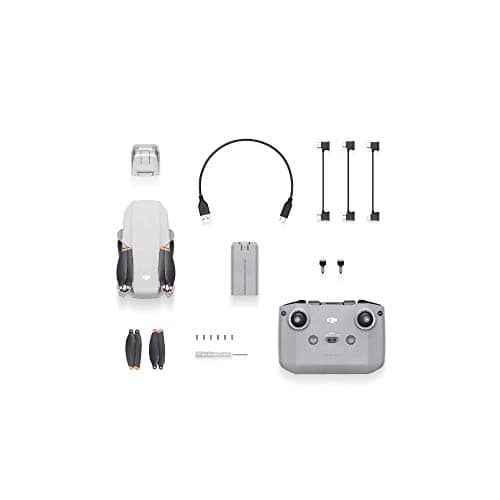
Conclusion
The DJI Mini 2 is currently the best drone for under $500 in our opinion and offers outstanding value for money. The ultra-compact and lightweight drone features a 3-axis mechanical gimbal and shoots crisp 4K video at 30 fps.
Compared to the previous version, DJI has now given the Mini 2 the OcuSync 2.0 professional transmission system, which enables ranges of up to 6.2 miles (10 kilometers) and ensures a much more stable signal transmission.
Other new features include a slightly longer flight time, revised remote control, a higher top speed, and the ability to now take photos in RAW format.
Obstacle sensors, color profiles for the camera or FocusTrack are unfortunately not found; these features are still reserved for the more expensive DJI models. Nevertheless, the equipment is remarkable, especially when you consider the compact dimensions and the relatively low price.
We think DJI has given the Mini 2 some extremely practical innovations that will certainly prompt one or two owners of a Mavic Mini to get the new version. One thing is for sure: You won’t find a better drone with a camera for less than 500 dollars!

